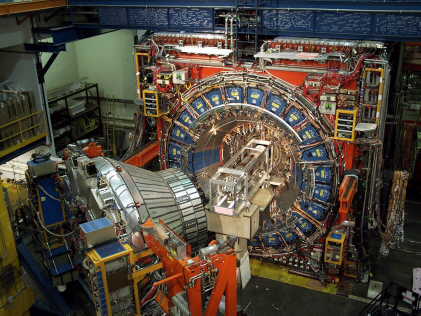The top quark is the heaviest of all fundamental components of matter, but extremely difficult to detect due to its short lifetime. So far, only pairs of top quarks have been detected. First detection happened 14 years ago at the Tevatron accelerator of Fermilab in the
Quarks are fundamental components of matter that compose among others particles in the atomic nucleus - protons and neutrons. The heaviest and last of the six quarks known, the top quark, was detected 14 years ago at the Tevatron particle accelerator of Fermilab near
A working group from the Institute for Experimental Nuclear Physics of the Karlsruhe Institute of Technology (KIT) was significantly involved in these experiments. Its head, Professor Dr. Thomas Müller, took part in the first discovery of the top quark already. “Since 1995, we have been waiting for the detection of the formation of individual top quarks”, says Müller. “This is one of the rare breakthroughs in experimental elementary particle physics.”
Many physicists hoped for deviations from theoretical predictions. Müller continues: “We know that the so-called standard model must be incomplete. Under extreme conditions, as those prevailing shortly after the Big Bang, it is no longer valid. The standard model only is the boundary case of a more universal theory.”
When physicists speak of a “standard model”, they mean their conception of the world of smallest particles and fundamental forces. Among others it describes the setup of matter that is composed of six different quarks and leptons each and the structure of the forces between them. While the lightest of these particles make up today’s matter, the remaining particles decomposed during the first billionths of a second after the Big Bang already. Their principle existence can only be demonstrated (and, hence, the processes taking place in the early universe can only be understood) at highest-performance particle accelerators. Such accelerators produce e.g. quarks and their antiparticles, anti-quarks, from pure energy according to Einstein’s principle E=mc2. Their decomposition products are then detected in electronic detectors as high as houses.
Interestingly, the reaction discovered now represents an important background for an even rarer particle, the Higgs boson that is also searched for feverishly at Fermilab. This particle that still remains to be discovered is considered the origin of mass of all matter. If may be doubted, however, whether the performance of the
These measurements and, of course, the search for the Higgs boson and possible signals of the mysterious dark matter will be continued in the future at the higher-performance Large Hadron Collider LHC at CERN in
The Karlsruhe Institute of Technology (KIT) is the merger of the Forschungszentrum Karlsruhe, member of the Helmholtz Association, and the Universität Karlsruhe. This merger will give rise to an institution of internationally excellent research and teaching in natural and engineering sciences. In total, the KIT has 8000 employees and an annual budget of 700 million Euros. The KIT focuses on the knowledge triangle of research – teaching – innovation.
The Karlsruhe institution is a leading European energy research center and plays a visible role in nanosciences worldwide. KIT sets new standards in teaching and promotion of young scientists and attracts top scientists from all over the world. Moreover, KIT is a leading innovation partner of industry.

